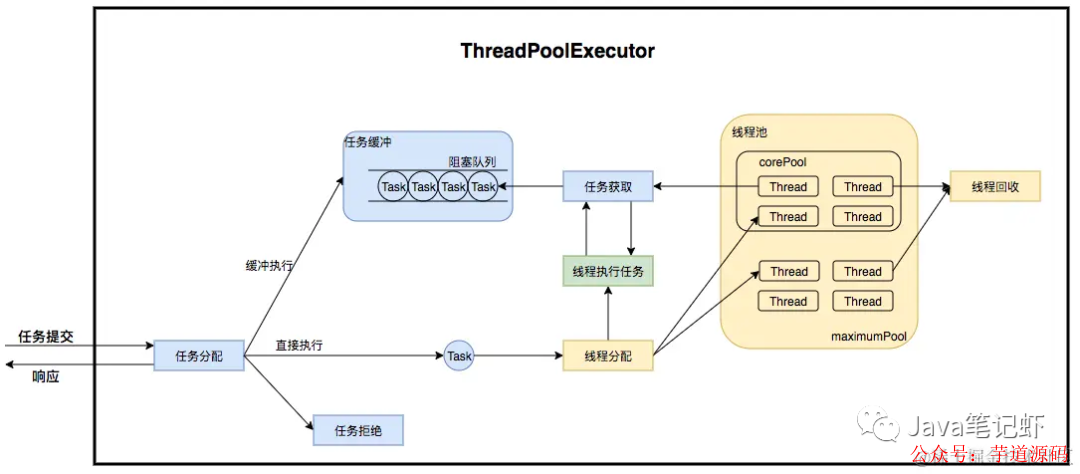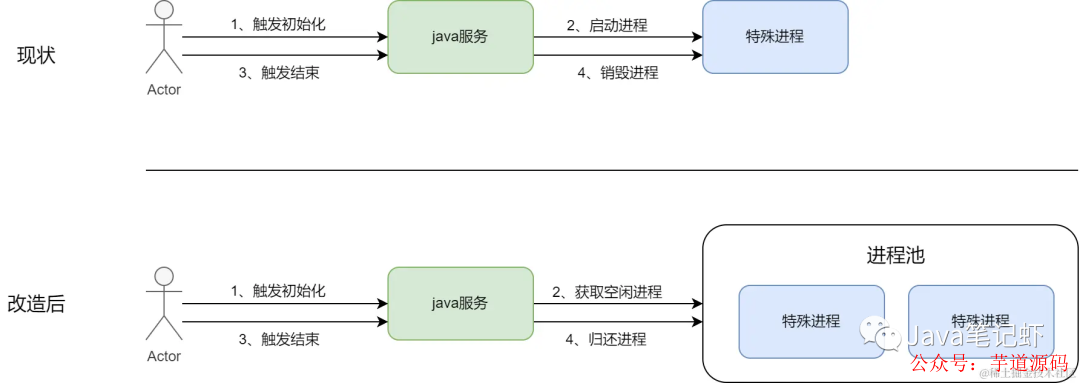

线程池的运转流程图 池化技术实践案例解析
电子说
描述
1 一些废话
作为一名Java开发人员,池化技术或多或少在业务代码中使用。常见的包括线程池、连接池等。也是因为Java语言超级丰富的基建,基本上这些池化能力都有着相对成熟的“工具”。
比如,需要使用线程池的时候常常会选择Spring提供的 ThreadPoolTaskExecutor , 工具内部替我们维护了线程的生命周期与任务的状态变化。
线程池的运转流程图

2 正文开始
在笔者的业务场景里,java服务需要通过命令行启动一个特殊进程,并在进程使用完后将其销毁。而业务对启动这个进程的整体耗时较为敏感,打算利用池化技术,将进程池化复用,去除启动进程的消耗,达到优化性能的目标。

认识 GenericObjectPool
池化技术的概念大家可能都比较熟悉了,但真正要从零开始实现池化能力,就会感觉困难很多。好在Java丰富的基建在提供ThreadPoolTaskExecutor的同时,也提供了GenericObjectPool这个辅助我们实现自定义对象池化的工具。顺带提一句:JedisPool就是使用这个工具实现的。
GenericObjectPool构造方法一共就3个参数,只有PooledObjectFactory必传;
/**
* Creates a new {@code GenericObjectPool} that tracks and destroys
* objects that are checked out, but never returned to the pool.
*
* @param factory The object factory to be used to create object instances
* used by this pool
* @param config The base pool configuration to use for this pool instance.
* The configuration is used by value. Subsequent changes to
* the configuration object will not be reflected in the
* pool.
* @param abandonedConfig Configuration for abandoned object identification
* and removal. The configuration is used by value.
*/
public GenericObjectPool(final PooledObjectFactory factory,
final GenericObjectPoolConfig config, final AbandonedConfig abandonedConfig) {
}
PooledObjectFactory 按照方法注释的描述,它是专门负责给池子创建对象实例的。当然除了创建对象(makeObject), 还包括了检验、激活、销毁对象。基本涵盖了对象生命周期中的各个阶段。
void activateObject(PooledObjectp) throws Exception; void destroyObject(PooledObject p) throws Exception; PooledObject makeObject() throws Exception; void passivateObject(PooledObject p) throws Exception; boolean validateObject(PooledObject p);
更加详细的说明可以浏览 GenericObjectPool's apidocs [1]。源码的注释也很详细值得一看。
使用 GenericObjectPool
先引入依赖
org.apache.commons commons-pool2 ${version}
根据自身业务实现PooledObjectFactory接口;作者的业务场景是进程池化,那么对应的创建对象、销毁对象的方法就是创建进程和销毁进程的代码。
public class MyProcessFactory implements PooledObjectFactory{ @Override public void destroyObject(PooledObject p) throws Exception { final MyProcess process = p.getObject(); if (null != process) { // 销毁进程 process.stop(); } } @Override public PooledObject makeObject() throws Exception { // 这里就是去创建一个进程 MyProcess process = new MyProcess(); process.start(); return new DefaultPooledObject<>(process); } // 剩下几个方法也可以按需实现 }
下一步就是构建 GenericObjectPool 实例
PooledObjectFactoryfactory = new MyProcessFactory(); GenericObjectPool pool = new GenericObjectPool(factory);
使用GenericObjectPool
// 获取进程实例 MyProcess process = pool.borrowObject(); // 归还实例 pool.returnObject(process);
进阶使用 GenericObjectPoolConfig
顾名思义,GenericObjectPoolConfig是池化工具的配置类;它包含了池的最大容量、池的最大空闲数、最小空闲数等核心参数。除此之外在它的父类 BaseObjectPoolConfig 中,空闲对象检测规则,对象存放队列进出规则(LIFO)等更加细节的配置。
/**
* The default value for the {@code maxTotal} configuration attribute.
* @see GenericObjectPool#getMaxTotal()
*/
public static final int DEFAULT_MAX_TOTAL = 8;
/**
* The default value for the {@code maxIdle} configuration attribute.
* @see GenericObjectPool#getMaxIdle()
*/
public static final int DEFAULT_MAX_IDLE = 8;
/**
* The default value for the {@code minIdle} configuration attribute.
* @see GenericObjectPool#getMinIdle()
*/
public static final int DEFAULT_MIN_IDLE = 0;
通过调整这些参数值,就能创建符合业务要求的池子。下面就是能常驻4个进程的一套配置参数。
private GenericObjectPoolConfiggenericObjectPoolConfig() { final GenericObjectPoolConfig config = new GenericObjectPoolConfig<>(); config.setMaxTotal(20); // 池的最大容量 config.setMaxIdle(4); // 最大空闲连接数 config.setMinIdle(0); // 最小空闲连接数 config.setMaxWait(Duration.ofSeconds(5)); // 获取对象时最大等待时间 config.setTimeBetweenEvictionRuns(Duration.ofMinutes(1)); // 空闲对象检查间隔 config.setMinEvictableIdleTime(Duration.ofMinutes(10)); // 空闲对象被移除的最小空闲时间 config.setTestOnBorrow(true); config.setLifo(false); return config; }
3 后续
当然真实的业务中还会有很多不相关的逻辑夹杂其中,上文基本涵盖了池化对象搭建与配置的实现方法。最终也实现了性能优化的目标。希望此文能为大家在池化运用多些帮助。
审核编辑:黄飞
-
买药秒送 JADE动态线程池实践及原理浅析2024-09-04 1522
-
动态线程池思想学习及实践2024-06-13 1876
-
什么是动态线程池?动态线程池的简单实现思路2024-02-28 1488
-
线程池七大核心参数执行顺序2023-12-04 1828
-
池化技术的应用实践2023-11-24 1022
-
线程池基本概念与原理2023-11-10 1403
-
了解连接池、线程池、内存池、异步请求池2023-11-09 2127
-
Spring 的线程池应用2023-10-13 1306
-
Java中的线程池包括哪些2023-10-11 1277
-
基于Nacos的简单动态化线程池实现2023-01-06 1419
-
线程池是如何实现的2022-02-28 1455
-
基于线程池技术集群接入点的应用研究2010-01-22 634
全部0条评论

快来发表一下你的评论吧 !

